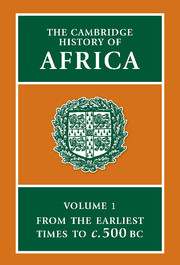Book contents
- Frontmatter
- 1 The palaeo-ecology of the African continent: the physical environment of Africa from earliest geological to Later Stone Age times
- 2 Origins and evolution of African Hominidae
- 3 The earliest archaeological traces
- 4 The cultures of the Middle Palaeolithic/Middle Stone Age
- 5 The Late Palaeolithic and Epi-Palaeolithic of northern Africa
- 6 The Later Stone Age in sub-Saharan Africa
- 7 The rise of civilization in Egypt
- 8 Beginnings of pastoralism and cultivation in north-west Africa and the Sahara: origins of the Berbers
- 9 The origins of indigenous African agriculture
- 10 Old Kingdom, Middle Kingdom and Second Intermediate Period in Egypt
- 11 Early food production in sub-Saharan Africa
- 12 Egypt, 1552–664 BC
- Bibliographical essays
- Bibliography
- Index
- Fig. 3.5 The distribution of sites known or believed to be older than 1.5 million years (i.e. Oldowan). (Modified from J. D. Clark 1967.)
- Fig. 3.6 The distribution of sites known or believed to be between 1.5 and 0.7 million years (i.e. Early Acheulian and Developed Oldowan).">
- Fig. 3.7 The location of Earlier Stone Age and Lower Palaeolithic sites thought to be between 0.7 and 0.1 million years old (i.e. Acheulian plus Developed Oldowan/Hope Fountain).
- Fig. 3.16 The ‘Zinjanthropus’ site at FLK, Bed I, Olduvai Gorge. A plan showing the distribution of an old ground–surface which was uncovered by excavation. A dense patch of discarded artifacts and introduced stones (manuports) coincides with a dense patch of broken–up animal bones. (After M. D. Leakey 1971.)
- Plate Section
- Plate Section
- Plate Section
- Plate Section">
- Plate Section
- Plate Section
- Plate Section
- References
4 - The cultures of the Middle Palaeolithic/Middle Stone Age
Published online by Cambridge University Press: 28 March 2008
- Frontmatter
- 1 The palaeo-ecology of the African continent: the physical environment of Africa from earliest geological to Later Stone Age times
- 2 Origins and evolution of African Hominidae
- 3 The earliest archaeological traces
- 4 The cultures of the Middle Palaeolithic/Middle Stone Age
- 5 The Late Palaeolithic and Epi-Palaeolithic of northern Africa
- 6 The Later Stone Age in sub-Saharan Africa
- 7 The rise of civilization in Egypt
- 8 Beginnings of pastoralism and cultivation in north-west Africa and the Sahara: origins of the Berbers
- 9 The origins of indigenous African agriculture
- 10 Old Kingdom, Middle Kingdom and Second Intermediate Period in Egypt
- 11 Early food production in sub-Saharan Africa
- 12 Egypt, 1552–664 BC
- Bibliographical essays
- Bibliography
- Index
- Fig. 3.5 The distribution of sites known or believed to be older than 1.5 million years (i.e. Oldowan). (Modified from J. D. Clark 1967.)
- Fig. 3.6 The distribution of sites known or believed to be between 1.5 and 0.7 million years (i.e. Early Acheulian and Developed Oldowan).">
- Fig. 3.7 The location of Earlier Stone Age and Lower Palaeolithic sites thought to be between 0.7 and 0.1 million years old (i.e. Acheulian plus Developed Oldowan/Hope Fountain).
- Fig. 3.16 The ‘Zinjanthropus’ site at FLK, Bed I, Olduvai Gorge. A plan showing the distribution of an old ground–surface which was uncovered by excavation. A dense patch of discarded artifacts and introduced stones (manuports) coincides with a dense patch of broken–up animal bones. (After M. D. Leakey 1971.)
- Plate Section
- Plate Section
- Plate Section
- Plate Section">
- Plate Section
- Plate Section
- Plate Section
- References
Summary
INTRODUCTION
The ‘Middle Palaeolithic’, to use the term current in North Africa and the Sahara, or the ‘Middle Stone Age’, as it is known to archaeologists working south of the desert, is that part of the prehistoric cultural record that follows the Lower Palaeolithic or Earlier Stone Age, and precedes the Upper Palaeolithic or Later Stone Age. This might seem so obvious as to be hardly worth mentioning but it is at least a statement that few archaeologists would dispute whereas attempts to define these ‘Ages’ more specifically – in terms of time, artifact assemblages, technological and socio-economic levels or on the basis of the associated human physical types – all result in considerable divergence of views.
In Eurasia and northern Africa, there has been a tendency to use the term ‘Middle Palaeolithic’ synonymously with that of the most characteristic industrial or techno-complex of the early and middle stages of the Last Glaciation, namely the Mousterian, a complex exhibiting several distinct traditions both in time and space. But there are also other industrial entities that are closely related through technique and/or chronological affinities which can less easily be accommodated under the term Middle Palaeolithic. In addition, it can also now be demonstrated that the essential characteristics that constitute the Mousterian Complex began well before the early Würm Glaciation and not only extend back into the preceding interglacial episode (Eemian) but have technical origins (i.e. proto-Levallois method (see p. 255)) which are closely rooted in the Acheulian in the Middle Pleistocene.
Keywords
- Type
- Chapter
- Information
- The Cambridge History of Africa , pp. 248 - 341Publisher: Cambridge University PressPrint publication year: 1982
References
- 26
- Cited by



